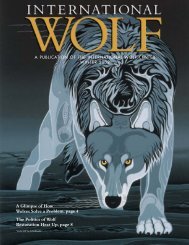Fall 2012 - International Wolf Center
Fall 2012 - International Wolf Center
Fall 2012 - International Wolf Center
Create successful ePaper yourself
Turn your PDF publications into a flip-book with our unique Google optimized e-Paper software.
From the Chair of the Board of DirectorsINTERNATIONALWOLF CENTERBOARD OF DIRECTORSPlease Welcome OurNew Executive DirectorAfter a national search, directors of the <strong>International</strong><strong>Wolf</strong> <strong>Center</strong> are thrilled to announceRob Schultz as the <strong>Center</strong>’s new executivedirector. Rob’s leadership experience in nonprofitorganizations, his fundraising expertiseand his skill in working with boards and guiding staffbrought him to the top of our list of 109 candidates.A parks and recreation graduate ofMankato State University, Rob hasworked in the nonprofit sector for theRob Schultzpast 20 years. At the age of 27, he was appointed executive director ofthe <strong>International</strong> Peace Garden—a botanical garden straddling theborder between the Canadian province of Manitoba and the U.S. state ofNorth Dakota. During his tenure at the Peace Garden, Rob worked tirelesslyto grow annual park visits to more than 250,000, making it NorthDakota’s second-largest tourism destination.Nancy jo Tubbs He has also held leadership roles in other nonprofits including:executive director of the YMCA’s Camp St. Croix, Hudson, Wisconsin;director of the Humanities <strong>Center</strong>, Saint Paul, Minnesota; and capital campaign directorof the Boy Scouts of America’s Northern Star Council, Minneapolis. Its successful $25million capital fundraising campaign reached goal nine months ahead of schedule.Most recently, Rob served as executive director of the Saint Paul Police Foundation, anonprofit organization that provides financial support to the Saint Paul Police Department.Since 2005, the Saint Paul Police Foundation has provided nearly $2 million in fundingand grants for the department’s special initiatives. In his former position, Rob worked withdonors and the foundation board to secure funding and support from the community.Rob is an active Rotarian and continues to volunteer with the Boy Scouts, serving asa member of the President’s Cabinet and chairing a scholarship program that has providednearly 150 college scholarships in the last five years. He is also an Eagle Scout.Rob, who joined the <strong>Center</strong> May 16, said his first weeks have been “rewarding andexciting.” His focus will be on guiding the <strong>Center</strong> during this “pup year” and preparingfor the <strong>Center</strong>’s international symposium in 2013.Due to Rob’s love of camping, photography, travel, and spending time in the outdoorswith his golden retriever, Rusty, we know Rob will easily become a key member of the<strong>Center</strong>’s family. Please join us in welcoming him. nNancy jo Tubbs, Board ChairAndrew EngelhartNancy jo TubbsChairDr. L. David MechVice ChairCree BradleySecretaryPaul B. AndersonTreasurerDebbie HinchcliffeNancy GibsonJudy HunterDavid MerharDr. Rolf O. PetersonMike PhillipsDebbie ReynoldsJerry SandersPaul SchurkeTed SpauldingDick ThielDeb WellsRay WellsTeri WilliamsEXECUTIVE DIRECTORRob SchultzMISSIONThe <strong>International</strong> <strong>Wolf</strong><strong>Center</strong> advances the survivalof wolf populations byteaching about wolves, theirrelationship to wildlands and thehuman role in their future.Educational services andinformational resourcesare available at:1396 Highway 169Ely, MN 55731-8129, USA800-ELY-WOLF218-365-4695email address:internationalwolf@wolf.orgWeb site: www.wolf.org<strong>International</strong> <strong>Wolf</strong> <strong>Fall</strong> <strong>2012</strong> 3
21st century. Wild wolves usuallyavoid close inbreeding, but did M 93evaluate the genetic viability of hispotential mates and decide that hisown daughter was a better bet thanany of the native females?By 2010, scat analysis for DNAindicated that only two females werepresent in the population. Males predominatedamong the 101 individualwolves that lived on Isle Royale during1999-2010, but sex ratio imbalancereached an extreme while the populationwas lowest. Funding limitationshave meant that DNA samples from2011 and <strong>2012</strong> remain unstudied,and in winter <strong>2012</strong> only one femalewas obvious. So it was a surprising andsignificant development in late April<strong>2012</strong> when a young adult female wascaptured and radio-collared. Eventhough this wolf has not yet bred, twofemales are much better than one.What will happen next is anyone’sguess. However, for this populationthe reality of extinction has never beencloser. The U.S. National Park Servicehas begun a process for evaluatingpossible management responses, whichmight include intervening beforeextinction, restoring wolves afterextinction or doing nothing to staveoff extinction or respond to it, shouldthat occur. Part of this deliberationincludes the realization that wolvescannot get to Isle Royale over the icevery easily anymore, as the probabilityof an ice bridge in any given winterhas been reduced from almost 80 percentto less than 10 percent since thebut Not Out1960s. Isle Royale has been called thewildest of our national parks, but it isnot so wild as to be isolated from theglobal human footprint. nRolf Peterson is a research professor atMichigan Technological University inHoughton, Michigan. He has been involvedwith studies of wolves at Isle Royale andelsewhere since 1970 and is a member ofthe board of the <strong>International</strong> <strong>Wolf</strong> <strong>Center</strong>.Michigan Technological UniversityNew Data Arrives,Explaining Higher MortalityA second female wolf inIsle Royale National Parkwas confirmed in April <strong>2012</strong> whenthis young non-reproducing wolfwas captured and radio-collared.Sally IrmigerOn June 7, <strong>2012</strong>, acting on a tip from abiologist studying a nearby lake, my wife,Carolyn, and I went to investigate whatappeared to be one or more floating animalcarcasses deep in an abandoned 19th centurymine shaft. We fished out decomposing remainsof three wolves and salvaged their skeletonsfor cleaning, study and preservation. The deadwolves included an 8-month-old female pup,an old male and a radio-collared malethat was about 6 years old, probably all fromthe Chippewa Harbor pack. We could onlyspeculate about how this might have happened,but accumulating snow and ice (and possiblythin ice) probably played a role. During the<strong>2012</strong> winter study we had only heard a coupleerrant beeps from the collar, and we did notobserve the collared male anywhere. This eventhelps explain the high mortality (about 45%)of 2011-12, reducing the unexplained mortalityto near the usual level (about 25%). The wolfpopulation has endured many unfortunateand unanticipated events. Readers areencouraged to follow this story to see how theIsle Royale wolves manage this time around(www.isleroyalewolf.org). —R.P.<strong>International</strong> <strong>Wolf</strong> <strong>Fall</strong> <strong>2012</strong> 5
Allan ClaybonElizabeth MurrayMex <strong>Wolf</strong> Interagency Field TeamFort ApacheIndian Reservation1040PhoenixARIZONANonessentialPrimaryRecovery ZoneNEW MEXICOSanta FeExperimental Zone10SecondaryRecovery ZoneIn 1977 and 1978, the last knownfive wild Mexican wolves were capturedin Durango and Chihuahua,Mexico, to establish a captive breedingpopulation. In 1995, two additionallineages of pureMexican wolves, held in40captivity in the UnitedStates, were integratedinto the captive breedingprogram, increasing thefounder population toseven.Due to the perilousstatus of the Mexican wolfand the uncertainty overwhether captive-rearedwolves could successfullybe returned to the wild, the 1982 Mexican<strong>Wolf</strong> Recovery Plan stated thatdelisting might never be possible. Theprimary goal of the plan was to ensurethe survival of the species by maintaininga captive breeding program andreestablishing a population of at least100 Mexican wolves in the wild.From those first 7 wolves, wenow have a captive breeding programconsisting of a motivatedand supportive group of wolf caretakerswho manage approximately300 Mexican wolves in 50 facilitiesin the United States and Mexico.Because this captive population is derivedfrom such a small number ofwolves and is the sole source of Mexicanwolves available to reestablish the species,managing for the genetic diversityof both wild and captive populations isone of our greatest challenges.The first 11 captive-reared Mexicanwolves were released into the BlueRange <strong>Wolf</strong> Recovery Area (BRWRA) in1998. The Blue Range wolves havenow adapted to hunting and living inthe wild and are successfully movingfrom a largely captive-released populationto a wild one. More than 95percent of the 58-plus Mexican wolvesliving in the wild in Arizona and NewMexico today were conceived and bornin the wild. We now have fourth-10 <strong>Fall</strong> <strong>2012</strong> www.wolf.org
Stephanie BidwellMex <strong>Wolf</strong> InteragencyField Teammember Mexican <strong>Wolf</strong> InterdictionStakeholder Council represents countycoalitions, tribes, the ranching communityand environmental organizationsin New Mexico and Arizona.This collaborative approach has ledto significant progress toward resolvinglongstanding conflict related tolivestock production and wolf conservation.The goals of the council are tomaintain healthy western landscapesand communities while supportingranching operations and viable wolfpopulations. Healthy landscapes areless likely to be fragmented andmore likely to provide areas for livestockproduction to coexist with wolfconservation.With our renewed goals, the growingstrength of our partnerships andthe recent increase in the populationof wild Mexican wolves, we have greatoptimism for the future of the Mexicanwolf. As Dave Mech stated recentlyat a lecture in Tucson, Arizona, “Gettinga population of wild wolves startedwith only captive wolves to release isa very tough proposition. However,the hardest part is now over, and thecurrent, robust population of severalwild-raised generations is now in anexcellent position to really move thiseffort forward.” nSherry Barrett is the Mexican wolfrecovery coordinator for theU.S. Fish and Wildlife Service.Will we see you at thisyear’s Alpha Weekend?The Alpha Weekend is a special recognitionbenefit for Alpha Legacy, Alpha <strong>Wolf</strong> and <strong>Wolf</strong>Sponsor members. Experience behind-the-scenesactivities, lectures and much more. Join us inEly, Minnesota, September 14-16, <strong>2012</strong>, for anunforgettable adventure.RSVP to Kristine at 763-560-7374 (ext. 228)or email koberg@wolf.org.12 <strong>Fall</strong> <strong>2012</strong> www.wolf.org
The early whelping periodresulted in large pups bysummer and in the pupintroduction being movedup by a week.Ed StimpsonEd StimpsonWhen Luna (far left) was on restrictedactivity, she had to be isolated, butstaff slowly transitioned her backinto interactions with Boltz .<strong>2012</strong> Litter:Oursixth litter also brought a unique change to our operations. While all other pupswere born between April 24 and May 12, the <strong>2012</strong> litter arrived a month early. Luna,a female pup, was born March 25 and Boltz, a male pup, was born March 17. We alsodidn’t acquire these two pups as neonates; we picked them up on April 13, making themthe oldest pups transitioning to our bottle-feeding regimen. We also had some healthchallenges with this set of pups, specifically with Luna, who has low bone density and afragile bone structure, making her susceptible to injuries. She suffered a femoral fractureMay 11 and required surgery that involved the insertion of a plate to repair the fracture.Her post-surgical recovery required that she spend some time isolated from Boltz until thefracture healed and nutritional supplements improved her bone density. At press time,Luna’s fracture was healing well, and we were transitioning her to spend time with Boltzand discussing plans for her future introduction into the Exhibit Pack. The next issue ofTracking the Pack will detail the pups’ introduction into the wolf enclosure with Aidan andDenali. We are reminding staff of the lessons learned with Nyssa when she was overlyprotected and are using our experience to shape our day-to-day operations in <strong>2012</strong>.The only certainty about raising pups is that every pup has its own unique personality,and every litter is different depending on gender, the source facility, the current dynamicsof the <strong>Center</strong>’s Exhibit Pack and the handling techniques used. While we learn from ourexperiences and apply that knowledge to current situations, there is no manual when itcomes to pup care. n16 <strong>Fall</strong> <strong>2012</strong> www.wolf.org
Internaltional <strong>Wolf</strong> <strong>Center</strong>Updates From Around the Globeby Tracy O’ConnellThe constant battle for and againstwolves continues globally.A brief summary of some ofwhat is happening around the world—both to conserve and eradicatewolves—is presented below.CHINA:Armed police are escortingsheep to protect them fromwolf attacks in Inner Mongolia,according to the Indo-Asian News Service, which said wolvesthere killed more than 1,000 livestockin 2011, equaling nearly one millionyuan (about $158,000 U.S.) in value.A local herder said the wolves’ moveto densely populated areas was new.One attack saw four to five wolves killingmore than 230 sheep in a penbelonging to several families. Owninga gun is illegal in Inner Mongolia.In eastern China’s Shandong province,attacks on seven people (two fatal)over six days led police to shoot a wolfin mid-March. But it is unknownwhether this was the wolf responsibleand if it was rabid. “The wolf is a protectedanimal, but shooting is justifiedwhen it threatens local people andtheir property,” the forestry departmentstated. Police are patrolling incase the culprit is still alive.NORWAY:Two political parties inNorway’s coalition government,the <strong>Center</strong> Party andthe environmentally mindedSocialist Left party (SV), are at odds.The <strong>Center</strong> Party supports farmers andranchers who feel threatened bywolves, while SV champions protectionof wolves, which were nearlyextinct in Norway until 20 years ago.Possibly three wolves have beenspotted in residential areas aroundOslo, but no one is panicking. A joggersaw a wolf in the middle of the trail,staring at him from a distance of 30meters (90 feet). “The wolf stood for afew seconds…then disappeared. It wasan exotic experience,” the jogger said.Another resident spotted a wolfbeing chased by a deer. Researchersfollowing the wolf, marked with anelectronic tracking device, said it’s ayear old, citing lack of experience forwhy the wolf was scared by a deerinstead of the other way around.FINLAND:A deeply rooted hatred ofwolves is blamed for poaching,which has halved thenation’s wolf population since2005, the Ministry of Forestry andAgriculture concluded after rulingout alternative theories. With licensedculling, only nine wolves would havebeen killed. Under scrutiny by theEuropean Commission, Finnish policehave ramped up investigations,including monitoring phone traffic,but cite an underlying conflict thatneeds to be worked out.SWEDEN:At least 450 wolves are necessaryto achieve favorable conservationstatus in Sweden,according to predator investigatorLars-Erik Liljelund, former directorgeneral of the EnvironmentalProtection Agency. Today there are anestimated 250 wolves.Sweden continues to strengthengenetic quality through a captivebreedingprogram and planned totransplant pups from parks to wilddens this year. Discussions withRussian wolf management officialsseek to introduce Russian wolves tothe Swedish genetic program.Meanwhile, the Nature Democrats,a new political party, has just one issue:<strong>International</strong> <strong>Wolf</strong> <strong>Fall</strong> <strong>2012</strong> 17
“When I first visited the <strong>International</strong> <strong>Wolf</strong> <strong>Center</strong>,Maya, Grizzer, Malik and Shadow still made up theExhibit Pack. I have followed the pack for a long timenow—when it’s getting pups, who’s retiring andthe social hierarchy within it as well. When Mayapassed away in March 2011—over a year ago now—I was very sad about what had happened. I drew apicture of her a few weeks later and sent it to the<strong>International</strong> <strong>Wolf</strong> <strong>Center</strong>. I enjoy spending time withmy dogs, mushing, drawing, drumming and beingoutdoors. I will be entering ninth grade this year atMinnetonka High School, in Minnetonka, Minnesota.”—Alika Rutter12 3Play!4 5Cris CrossFill in the squares with the answers or definitions using the cluesbelow. Use the word bank at bottom, or visit www.wolf.org/wolves/learn/basic/biology/pupdevelopment.asp if you need help!AcrossDown4. Our female ambassador 1. The kind of hair thatpup’s name.becomes apparent on6. When pups no longer wolf pups at 8-10drink milk from their weeks of age.mother and begin 2. The developmentaleating meat.stage right before7. Where the pups are born. a wolf pup becomesan adult.8. Our male ambassadorpup’s name.3. When pups are born,they can’t see.9. When pups are born,they can’t hear. 5. The site pups aretaken to after the den.10. The color of a pup’seyes when it is born.69Word Bank Regurgitate Den Blue Blind Luna Boltz Rendezvous Deaf Juvenile Guard Wean8710<strong>International</strong> <strong>Wolf</strong> Summer <strong>2012</strong> 23
Noninvasive Sampling InformsToday’s Wildlife Research(This is not your grandparents’ wildlife biology–Part II)by Nancy jo Tubbs, chair of the <strong>International</strong> <strong>Wolf</strong> <strong>Center</strong>At one time, scientists killed andtook the entire animal to studyit. As noninvasive samplingtechniques evolved, biologists couldminimize harm to the animal beingstudied and survey animal populationsin ways never before possible.The work became safer for researchersand reduced the need to trap animals.Noninvasive sampling techniquesinclude DNA analysis, camera trappingand remote sensing.MOLECULARGENETICS(First made practical in the 1980s)The television crime show CSI hasnothing on the world of wolf biologywhen it comes to DNA analysis. Ingenetic sampling, a small sample oftissue is taken to obtain DNA for study.Noninvasive methods involve studyinghair, urine, shed skin and intestinalcells in feces. It’s not necessary to catch,handle or even see the wild animal toestimate the survival rate of a populationor determine genetic diversity.Forensics studies can beused, for example, to determinewhether wild wolveshave hybridized with coyotesor dogs.POPULATIONVIABILITY ANALYSIS(PVA)(First used in the 1970s to predictgrizzly populations in Yellowstone)Want to know the probability of ananimal’s extinction within a numberof years? PVA input data includes variablessuch as population trends, preyspecies, habitat change and diseases.The results of these studies are usedin endangered species recovery plansand help wildlife managers assessthe potential of various managementscenarios.AUTOMATIC TRAILCAMERAS(Early trail cameras were used in 1877)Stationary cameras are automaticallytriggered by an animal’s motion to taketime-logged photographs. Using “cameratrapping,” biologists can estimatethe number and density of animalsin an area.REMOTE SENSING(Wilbur Wright first took an aerialphoto in 1909)To view and measure the changingcharacteristics of ecosystems, scientistsuse aerial and satellite-based photosof large areas taken over time. Imagescaptured from these flights are fedinto computer programs that analyzevariations, which might have beencaused by climate change, floods andeven indirectly by wolves that havebeen reintroduced, such as those inYellowstone National Park. Researchteams on the ground can investigatemore closely to analyze the causeof the changes shown in the remotesensing data. nU.S. Geological Survey/NationalAeronautics and Space Administration(USGS/NASA) LandsatShown is one type of trail camera.The image to the right was captured on atrail cam in Washington State in 2009.Conservation Northwest24 <strong>Fall</strong> <strong>2012</strong> www.wolf.org







